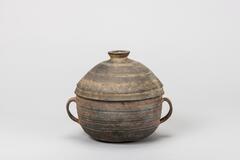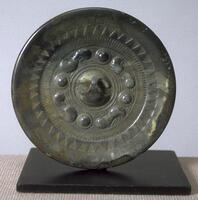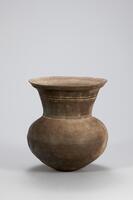8 UMMA Objects
8 UMMA Objects

Korean (Korean (culture or style))
Two-handled bowl with cover
400 – 599
Gift of Bruce and Inta Hasenkamp and Museum purchase made possible by Elder and Mrs. Sang-Yong Nam
2004/1.182A&B
![It has a flat base, globular body and straight neck with an everted rim. The color is dark grayish-blue.<br />
<br />
This is a blue-gray, high-fired stoneware cup with a handle. The mouth of the cup is slightly splayed and has a narrow, rounded rim. The body is widest at its center where a semicircular handle is attached vertically. The inner and outer surfaces show faint traces of rotation and water smoothing. The base is wide and flat and has no foot.
<p>[Korean Collection, University of Michigan Museum of Art (2017) p. 70]</p>
It has a flat base, globular body and straight neck with an everted rim. The color is dark grayish-blue.<br />
<br />
This is a blue-gray, high-fired stoneware cup with a handle. The mouth of the cup is slightly splayed and has a narrow, rounded rim. The body is widest at its center where a semicircular handle is attached vertically. The inner and outer surfaces show faint traces of rotation and water smoothing. The base is wide and flat and has no foot.
<p>[Korean Collection, University of Michigan Museum of Art (2017) p. 70]</p>](/media/W1siZiIsIjIwMjIvMDUvMjUvNGV2em85OThkdF9kZWZhdWx0LmpwZyJdLFsicCIsInRodW1iIiwiMjQweDIwMCJdXQ?sha=2d2a81114b915f5e)
Korean (Korean (culture or style))
Cup with small handle
400 – 599
Gift of Toshiko Ogita in memory of Tomoo Ogita
1987/1.310
![It looks like a rescent, animal's tooth or fetus. There is a hole and some carved line on the head part.<br />
<br />
This is a comma-shaped bead made from dark green jade. Such crescent moon-shaped beads, referred to as<em> gogok</em>, were used to decorate golden crowns, clothing, and belts. This example, which was attached to other ornaments via the hole in its head, is typical of comma-shaped beads of the Three Kingdoms period. Three parallel lines are incised across the hole, from which four more incised lines radiate upwards.<br />
[Korean Collection, University of Michigan Museum of Art (2017) p.33] It looks like a rescent, animal's tooth or fetus. There is a hole and some carved line on the head part.<br />
<br />
This is a comma-shaped bead made from dark green jade. Such crescent moon-shaped beads, referred to as<em> gogok</em>, were used to decorate golden crowns, clothing, and belts. This example, which was attached to other ornaments via the hole in its head, is typical of comma-shaped beads of the Three Kingdoms period. Three parallel lines are incised across the hole, from which four more incised lines radiate upwards.<br />
[Korean Collection, University of Michigan Museum of Art (2017) p.33]](/media/W1siZiIsIjIwMjIvMDUvMjUvNXUwNHN1cTN0Y19kZWZhdWx0LmpwZyJdLFsicCIsInRodW1iIiwiMjQweDIwMCJdXQ?sha=70118906356121f7)
Korean (Korean (culture or style))
Comma-shaped Pendant
400 – 599
Museum purchase made possible by the Margaret Watson Parker Art Collection Fund
1983/1.152

Japanese (Japanese (culture or style))
Mirror
400 – 599
Museum purchase made possible by the Margaret Watson Parker Art Collection Fund
1966/1.109

Korean (Korean (culture or style))
Pedestal Jar with Long Neck
400 – 599
Gift of Bruce and Inta Hasenkamp and Museum purchase made possible by Elder and Mrs. Sang-Yong Nam
2004/1.175

Korean (Korean (culture or style))
Round-Bottomed Jar with Wide Flared Mouth
400 – 599
Gift of Bruce and Inta Hasenkamp and Museum purchase made possible by Elder and Mrs. Sang-Yong Nam
2004/1.183
![It has a flat base, globular body and straight neck. There is no design on the surface of the body. The attached handle is a little small and thick.<br />
<br />
This is a gray, high-fired stoneware cup with a handle. Its mouth is completely upright, and its rim has a sharp edge. The section immdiately below the mouth tapers inwards and is then connected to the round body. The body is widest at the center. The handle is attached to the lower-central part of the body; the upper end of the handle penetrates the side of the cup, while the lower end is joined by simply rubbing it against the cup’s surface. There are traces of rotation and water smoothing on the inner and outer surfaces of the mouth. Natural glaze is visible in the parts around the round base.
<p>[Korean Collection, University of Michigan Museum of Art (2017) p. 68]</p>
<br />
It has a flat base, globular body and straight neck. There is no design on the surface of the body. The attached handle is a little small and thick.<br />
<br />
This is a gray, high-fired stoneware cup with a handle. Its mouth is completely upright, and its rim has a sharp edge. The section immdiately below the mouth tapers inwards and is then connected to the round body. The body is widest at the center. The handle is attached to the lower-central part of the body; the upper end of the handle penetrates the side of the cup, while the lower end is joined by simply rubbing it against the cup’s surface. There are traces of rotation and water smoothing on the inner and outer surfaces of the mouth. Natural glaze is visible in the parts around the round base.
<p>[Korean Collection, University of Michigan Museum of Art (2017) p. 68]</p>
<br />
](/media/W1siZiIsIjIwMjIvMDkvMjQvM3hwcXN2d2JncF9kZWZhdWx0LmpwZyJdLFsicCIsInRodW1iIiwiMjQweDIwMCJdXQ?sha=d4bed4501b68ec21)
Korean (Korean (culture or style))
Small Single-Handed Cup
400 – 599
Gift of Bruce and Inta Hasenkamp and Museum purchase made possible by Elder and Mrs. Sang-Yong Nam
2004/1.191
![It has narrow flat base, globular body and straight neck. The color is dark grayish-blue.<br />
<br />
This is a dark gray, low-fired earthenware cup with a handle. The body is widest at its center, to which a semicircular handle is attached vertically. The entire body retains traces of rotation and water smoothing, while the lower part of the outer surface also retains traces of paring by rotating. The base is flat and has no foot.
<p>[Korean Collection, University of Michigan Museum of Art (2017) p. 69]</p>
It has narrow flat base, globular body and straight neck. The color is dark grayish-blue.<br />
<br />
This is a dark gray, low-fired earthenware cup with a handle. The body is widest at its center, to which a semicircular handle is attached vertically. The entire body retains traces of rotation and water smoothing, while the lower part of the outer surface also retains traces of paring by rotating. The base is flat and has no foot.
<p>[Korean Collection, University of Michigan Museum of Art (2017) p. 69]</p>](/media/W1siZiIsIjIwMjIvMDUvMjUvMWl5OTRyNHJuYV9kZWZhdWx0LmpwZyJdLFsicCIsInRodW1iIiwiMjQweDIwMCJdXQ?sha=a3e0342a3c1984c9)
Korean (Korean (culture or style))
Cup with tiny handle
400 – 599
Museum purchase made possible by the Margaret Watson Parker Art Collection Fund
1982/2.54
Loading…
